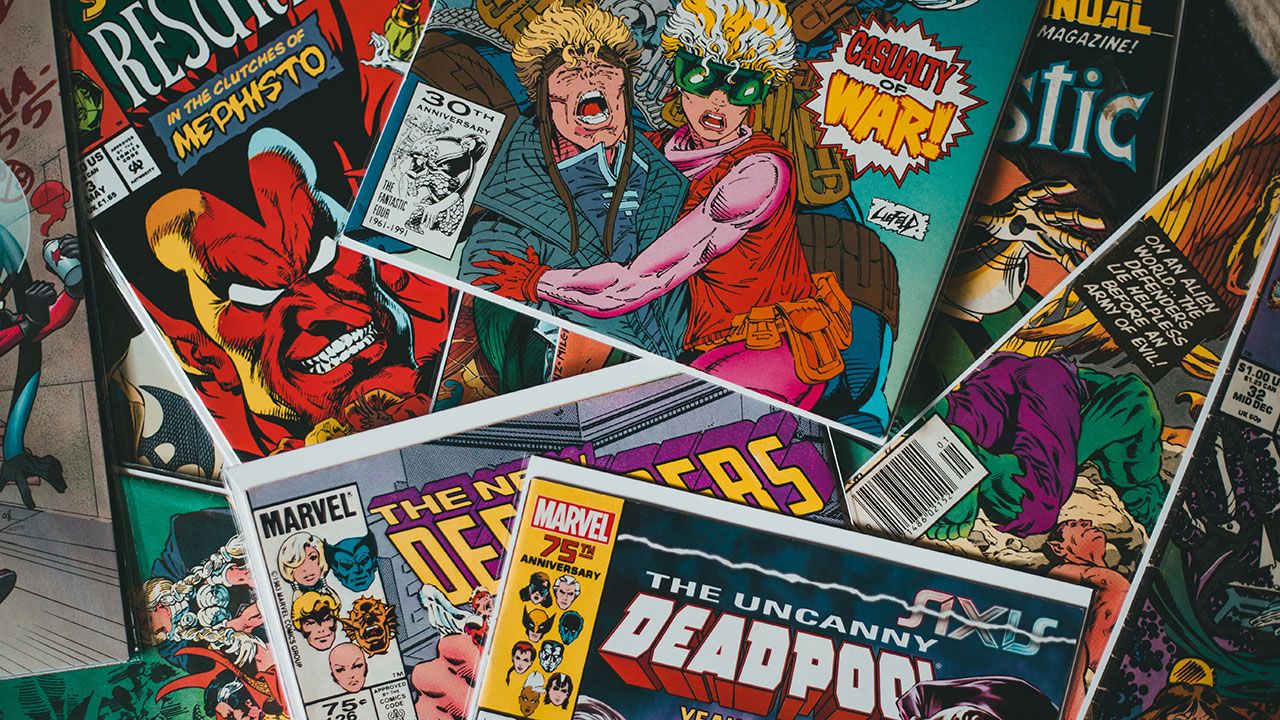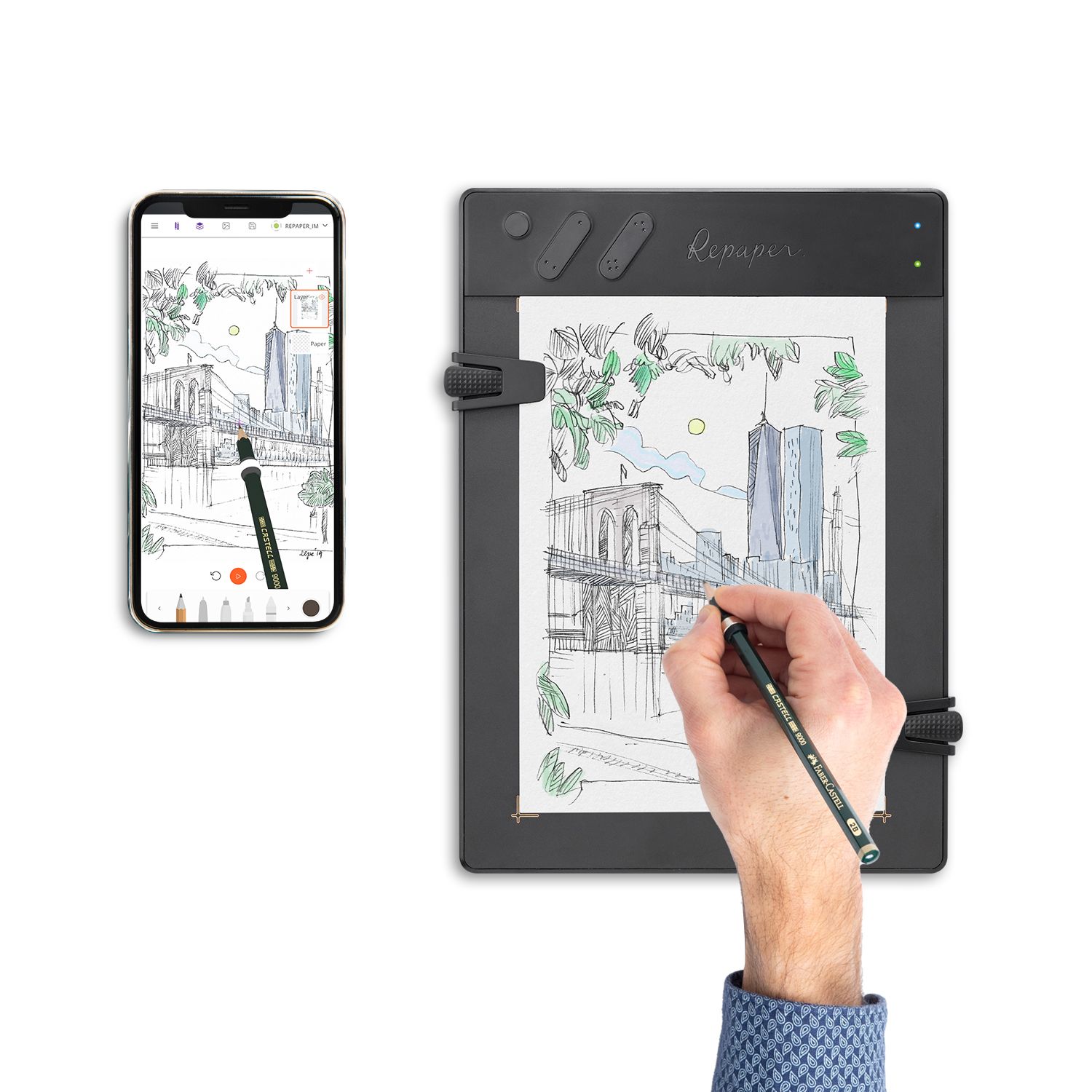
How to create a comic book with a graphics-tablet?
If the Americans have their comics and the Japanese their mangas, when talking about comics, we first think of the great French-Belgian comics, with great artists and scriptwriters like Hergé (Tintin), Franquin (Spirou and Fantasio) or René Goscinny and Albert Uderzo (Asterix and Obelix). If you've had a lot of ideas for scripts, and you've always wanted to create a comic book, we'll explain the different steps, as well as the ideal equipment to start your comic book, from the script to its colorization.
The type of material is an essential element in the creation of a comic book.
The process of making a comic book remains the same with a traditional pencil or with the help of computer tools. Drawing, inking, or even coloring and finishing, everything is now possible using a tablet and a suitable graphic design software, and drawing comic book strips has never been so easy. All you need to do today is learn about the right tools to avoid the frustration that some tablets and graphics software can cause, when first used, to the comic book artist used to working in the traditional way. If digital technology saves a lot of time, once the technique is mastered, some people do not find the same sensations that one can have with his/her favorite felt pens and pencils. It is therefore common to see a cartoonist, even a professional used to digital tools, using both techniques. However, it is now possible to overcome this problem thanks to the new peripherals that are increasingly taking their share of the graphic tablet market.


The drawing tablet, the illustrator's companion.
When you want to start creating a comic book with the help of a drawing tablet, you have to be able to adapt to this new tool, which is often disturbing at first. Indeed, the hand-eye coordination of tablets without screen is generally the most complicated aspect to learn when drawing a sketch in a digital format. Drawing a sketch while looking at your screen, and not your hand when making your comic book board is quite difficult, and requires a long practice, which can sometimes discourage beginners from drawing their illustrations on a computer. However, it is important to remember that knowing how to draw directly with a drawing tablet is a significant time saver for artists, and fortunately, technologies have evolved and new tablets have appeared, allowing to bridge almost instantly the classic pencil and digital techniques with a software.
The drawing tablet, like the ISKN Repaper, is definitely the ultimate way to draw a comic book in a natural way, with your usual pencils, thanks to its interface combining paper and digital drawing. Indeed, thanks to a graphic tablet, you just have to put a sheet of paper directly on the drawing surface of the tablet, sensitive to the pressure and the tilt of the pencil. Add a magnetic ring on any of your favorite pencils in order to reproduce the movements of your pen, thanks to the magnetometers located in the tablet, for a line faithfully reproduced on the screen. No more worries about hand-eye coordination, you can draw on paper as you would on a notebook or a drawing board, and the tablet will save you a lot of time to draw, ink, edit and colorize your illustrations. Furthermore, with a drawing tablet like the Repaper, you can even draw without software, your drawings are saved directly in the tablet's memory, and it's up to you to export them later to your favorite graphics software. This is an undeniable advantage for designers who like to work while traveling.

The graphic software to make perfect comics.
Once equipped with your drawing tablet, you need to think about choosing the right graphic design software that allows you to create a comic book very easily. Even if you could say that a software like Photoshop or Illustrator can be suitable, it may quickly be limited in terms of possibilities to work rapidly in the particular comic book format. That's why it's much more advisable to turn to specialized software like Clip Studio Paint or Krita, which will offer you a multitude of interesting options such as page layout and box cutting thanks to pre-formatted thumbnails and bubbles, brushes that reproduce the pencils used to create comics, taking into account the 8,192 levels of pressure offered by the best graphic tablets such as the ISKN Repaper, or even the management of layers, fonts, or perspective wizards to help you with your settings. If Krita is offered for free as free software, Clip Studio Paint also offers a free version to try it out, and a paid version at an attractive price for people who want a software truly adapted to comics, and without any real competition in this sector. Once you master it, you'll work more efficiently than on paper, thanks to the layout options, the layers and the undo shortcuts that speed up the production of illustrations, all without losing the feeling of drawing if you have the right tablet.

How to make a comic book: the essential steps.
Create the script.
Creating comic books starts with a good story. Unlike Japanese manga or American superhero comics, which are generally published in a regular way, in numbered chapters, the French-Belgian comic book is a finished work. It has a synopsis with a beginning, a middle and an end. Each book can generally be read independently, and the comic book writer's role will be to present and unfold the intrigue around the comic book characters he/she has created. Without a good script, your comic book will not be an accomplished work, which is why many comics are created with four hands, with an author and an illustrator.
Define your style.
The world of comics is vast, and before starting to draw a comic book novel, it is important for the comic book writer to know his/her audience in order to know what style of drawing he/she wants to produce. The genre chosen defines how to draw and how to tell the story of the comic book on which one will spend a significant amount of working time. The best comics usually have a very strong style, and whether you are making an adult comic, a children's comic or a comedy comic, the drawing style can be realistic or cartoonish. The layout that the scriptwriter and cartoonist will choose will also have an influence on the target audience. For short and light stories to be distributed on social networks, the comic strip of a few squares will be ideal, while for a more substantial and serious story, the graphic novel will have all its legitimacy. In order to keep a certain coherence, it is important to think carefully about these options, because unless a strong and desired editorial choice is made, one is obliged to keep one's style, format, as well as the tone used, throughout the creation process.

Making a storyboard.
Once you have your story and your style, you can begin to put your storyboard on paper. This can be thought of as a rough draft, or as the original boards of the comic book you will create. This is where you begin to roughly sketch out your comic book characters, and make your storyline readable in comic book form. The boxes are not yet formatted as they will be in the final format, but it can give you an idea of what you are going to achieve. It is also during the storyboarding process that you can let your imagination run wild and improvise new scenes that were not planned during the creation of the script. At the end of the process, you will have a complete story and quick drawings that give you a glimpse of what your comic book will look like.
Build your comic strips.
You have your story, and the content of each thumbnail is defined in your storyboard, it's time to build your comic strips by organizing your frames in a precise order and shape. Taking into account the reading direction is essential for the organization of your boxes. The reading of the bubbles and then of the thumbnails is done from left to right and from top to bottom, so you have to create the layout of these in order to leave no room for doubt. A simple trick is to slightly shift the separation line between each box so as not to have a perfect square which could mislead the reader when reading the board. Trying not to have the same layout from one panel to the next is also important so that the reader of your comic doesn't have the impression of having to do the same panel twice. It is also generally accepted that four lines of boxes is the maximum not to exceed for a good reading fluidity. In traditional comics, we must also try to respect the vertical geometry. Comic book boxes are generally rectangular, and if horizontally you can afford to make the length you want (again to avoid losing the reading direction), if you want to make a bigger box vertically, you have to think about taking the lower dividing lines as a reference, and not stop your frame in the middle of an adjacent vignette. This will avoid an anarchic look, which although used massively in Japanese manga, which uses various shapes of boxes, is not very well adapted to the more structured format of European comics. The goal of this maneuver is to obtain a tome that is pleasant to read, and dynamic for the eye, but also to organize your storyboard in a way that gives rhythm to your story as you go through the pages.

Draw and ink your comic book.
When your boards are ready to be completed, it's time to draw and ink your comic. This is where using a tablet and graphics software to create your storyboard and plates can be useful. In this way, and thanks to a clever management of layers, you can take each layer of the storyboard representing a vignette, and by putting it in transparency, take back the sketch using more advanced drawing techniques to obtain the final result. Then add your speech bubbles, or phylacteries, and the text in each one, and it's time to ink the whole thing to get a black-and-white result, close to the final result. In the same way, the use of a drawing tablet like the ISKN Repaper can be a real asset for those who like to see the results of their efforts in front of their hands, without having to deal with the particular hand-eye coordination imposed by drawing tablet without a screen, which require looking at the computer monitor to be able to follow the result of their work.
Colorize the comic book.
If you can decide to leave what you have drawn in black and white, it is also possible to work as a colorist and colorize your work. It is generally quite common in the French-Belgian comic strip to colorize comics, and for this, the graphics software can again help you in many ways. With it, you can precisely delineate the areas to be colored, without going beyond the outline of the vignette or the inked lines with a black marker. Also, you can determine your colors with an alphanumeric code, which can be very useful when sending to the printer who sometimes has only limited ranges of colors.

All you have to do is distribute your comic book.
Finally your comic is ready to be made public. You want to distribute it, and nothing could be easier. Thanks to many specialized sites, you can share your drawings created on the graphic software in the form of "scans", a format very popular with readers. For a more traditional distribution, approaching a renowned publishing house such as Delcourt and Glénat is also a possibility, unless you prefer self-publishing to enter the world of the ninth art by having realized everything from A to Z.

Discover more
How to draw caricatures: techniques for creating humorous drawings.
From the history of caricature, to the tricks to make them, discover the specificities of this particular art to draw your most beautiful caricature.
How to create a Manga? Tools, Techniques, and Digital Mastery
Manga has been popularized all over the world through mythical works such as Dragon Ball, One-Piece or Naruto, and many beginners want to learn drawing in order to create their own Japanese comic books.
How to Make a Cartoon: From Traditional Drawing to Digital.
Discover the techniques and steps to make perfect animations to create smooth and professional cartoons.
Newsletter
Keep up to date with iskn news and events
Free standard delivery
for purchase over $80
30-day returns
on all products
Secure payment
with Stripe & PayPal
Pay in 4
with PayPal
Customer service
chat with us


